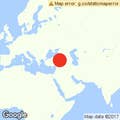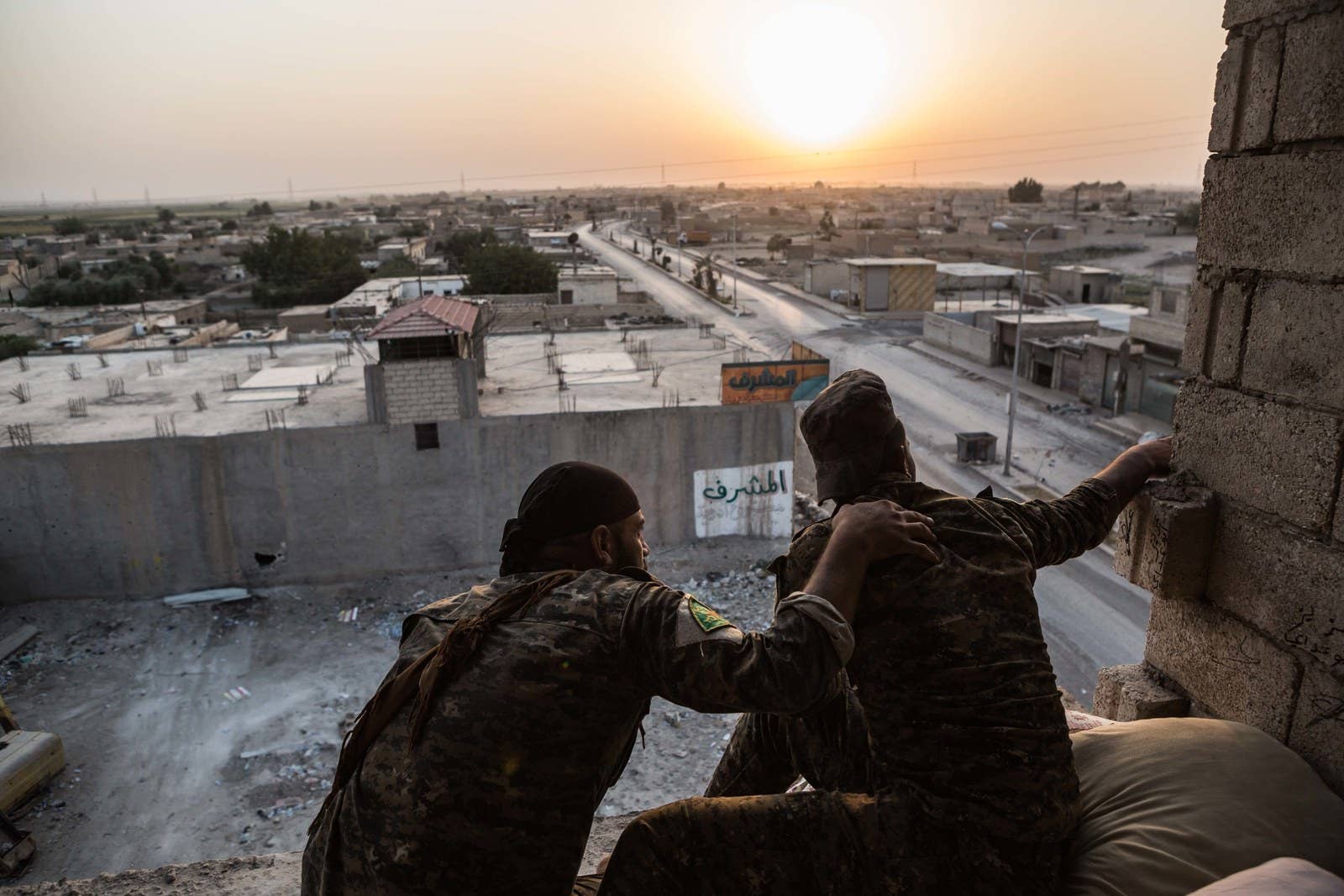
RAQQA, Syria — The Trump administration has dramatically increased US military and political involvement in northern Syria, providing air and ground support to local forces camped out in abandoned buildings on the outskirts of Raqqa as they seek to oust ISIS from the capital of its self-declared caliphate.
Under President Donald Trump, the US-led coalition has developed closer coordination with a collection of militias and tribes called the Syrian Democratic Forces (SDF), directing air and ground assaults. Senior State Department and USAID officials have visited Raqqa’s outskirts to coordinate efforts to help displaced civilians and secure the city’s future once ISIS is driven out. US officials have also carved out a semipermanent diplomatic presence close to the northern Syrian city of Kobane.
US and other Western security officials grill captured ISIS fighters, most of them held at a prison near Kobane, to glean intelligence on the jihadis, their future plans, and their ties to other fighters in the Middle East and the West, according to SDF fighters and Kurdish intelligence officials, as well as a former US military official. The efforts have made Trump popular among many of Syria’s autonomy-minded Kurds, with some praising him as a patron of their project to build a self-ruled enclave.
The ground war, launched late last year with skirmishes on the outskirts of Raqqa before reaching the city in early June, has become a grueling street battle, with tens of thousands of Syrian militiamen approaching from the east, west, and south. Each day, the SDF — a multiethnic, multireligious collection force mostly led by Kurdish commanders — struggles to force its way into the city, while US-led coalition planes circle overhead and laser-guided howitzer artillery guns manned by Marines stand ready. The SDF is strongly under the sway of the YPG, a Syrian offshoot of the outlawed Kurdistan Workers Party (PKK), a fact that creates huge tensions with the US’s NATO partner Turkey and may precipitate a raft of political problems once ISIS is defeated. But for now the SDF’s fighters are Washington’s best allies in northern Syria, risking their lives under extreme conditions in the slow, brutal effort to take Raqqa.
ISIS has controlled Raqqa for more than three years, building a network of tunnels, secret passages, and fortified positions. Field commanders say the fight isn’t just house to house, it’s often room to room. There is Raqqa, and then a second Raqqa hidden underground and in the cracks, said one commander who described a 14-hour battle just to get to the second floor of a building after taking control of the first floor. Unlike Iraqi troops operating in the recently liberated city of Mosul, few if any of the SDF fighters have body armor.
“In the city, you know what’s in front of you, but you don’t know what’s behind you.”
BuzzFeed News spent more than a week alongside the SDF in and around the city, speaking with Syrian military commanders and local and US officials, along with escaping civilians looking wearily forward to rebuilding their lives amid the rubble.
One of the field commanders is a man who goes by the nom de guerre Ali Shir, a 32-year-old Kurd from Kobane who joined the fight against ISIS when the Kurdish city was besieged in 2014. Before the siege he sold jeans at the market — now he commands 40 men. Sporting a thick mustache, and in traditional baggy Kurdish pants, Shir said he has no wife or children, and that until the war is over it’s better that way. He’s well aware of the dangers he and his men face. “When we were in the countryside it was easier,” said Shir before a recent offensive, sitting cross-legged with his men in a four-story construction site just beyond the city’s western front line that was being used by his forces as a temporary headquarters. “But in the city, you know what’s in front of you, but you don’t know what’s behind you.”
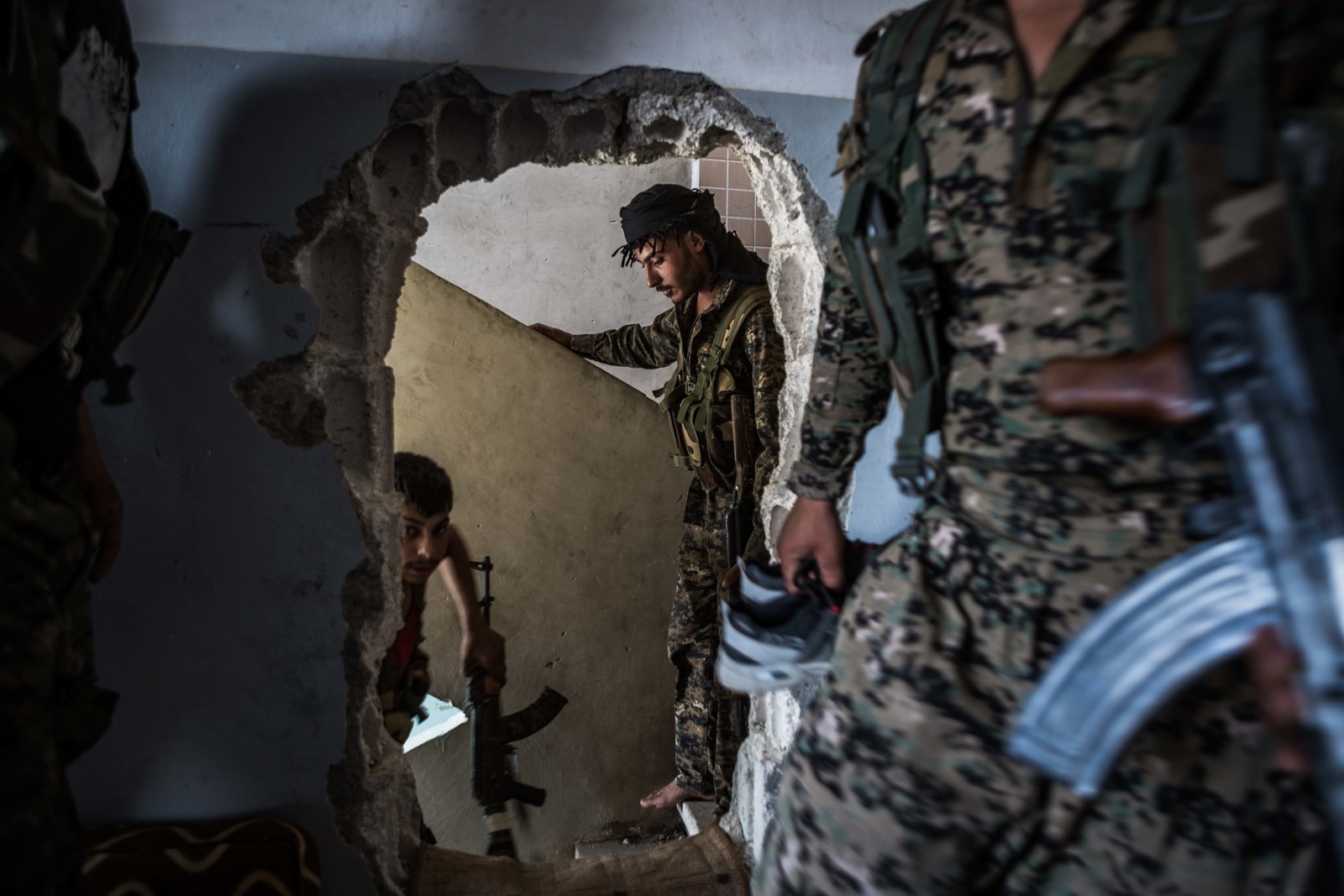
On a recent night Shir led his men, on foot, to cross the western perimeter deeper into ISIS-controlled Raqqa. Huddled in groups of seven, they took up positions in the cover of darkness. At dawn they moved, taking control of a small group of buildings across a road that had served as a front line. They crossed into contested territory without incident and spent the morning trying to clear buildings of mines. Equipment was improvised. They tossed gunpowder wrapped tightly in masking tape into buildings, to set off any booby traps left behind by ISIS. To clear roadways, they stuffed gunpowder into empty cigarette boxes and wrapped them with electrical wire, stringing them into chains and laying them out onto the streets before setting them off.
In the early afternoon, an ISIS fighter driving an explosives-laden car began hurtling toward them. There was momentary panic, but the men opened fire on the vehicle with everything they had, finally causing it to explode.
After clearing a building of mines, they radioed the grid coordinates to a makeshift tactical operations center a mile away from the front line run by a young Kurdish fighter whose nom de guerre is Rostam Halab. He brought a scientist’s precision to his job of managing the efforts of several battalion-sized units, marking the cleared buildings in yellow on a map on his Samsung tablet. Just a few years ago Halab had been a university student looking forward to the staid life of an engineer in Syria; now, at 26, he is working hand-in-hand with the US to fight ISIS.
Borzou Daragahi reports from Raqqa
“The building we want to take now is filled with bombs,” Shir told Halab over a walkie-talkie kept charged by a pack of batteries bundled together with masking tape.
“Do you think you can clear it?” Halab asked.
“No,” Shir replied. “All the building is mined. All of it.”
Halab said: “If you can take your very fastest guy, give him some dynamite, have him light it, throw it in there, and get out of there as fast he can.”
And then sniper fire came suddenly, pinning Shir’s men down.
Muzzle flashes could be seen from the sniper’s position inside the city. But there was nothing Shir or his men could do — at this point, retreating would be just as dangerous as advancing. So they did what they have to whenever ISIS manages to outmaneuver them in Raqqa: call for a US airstrike. They radioed in the coordinates of the sniper’s position to Halab, who passed them on to his SDF superiors. They sent the coordinates to their American counterparts, who relayed fresh orders to the US warplanes that swirl above the city 24 hours a day.
Within minutes, a series of rockets slammed into the building. The explosions could be heard for miles and sent a cloud of smoke spreading across the sky over the city. That was the end of the sniper fire, at least for the day.
Shir and his men moved to take full control of the small cluster of buildings they had in their sights. They were elated, hanging out of the windows of apartment buildings and posing for selfies. Even their typically reserved leader was in a celebratory mood.
But even with US-led air support and artillery, it had taken nearly 13 hours to advance about 150 yards across the front, and that after days of strikes on the quarter. There was still a mile and a half to go to reach Raqqa city center.
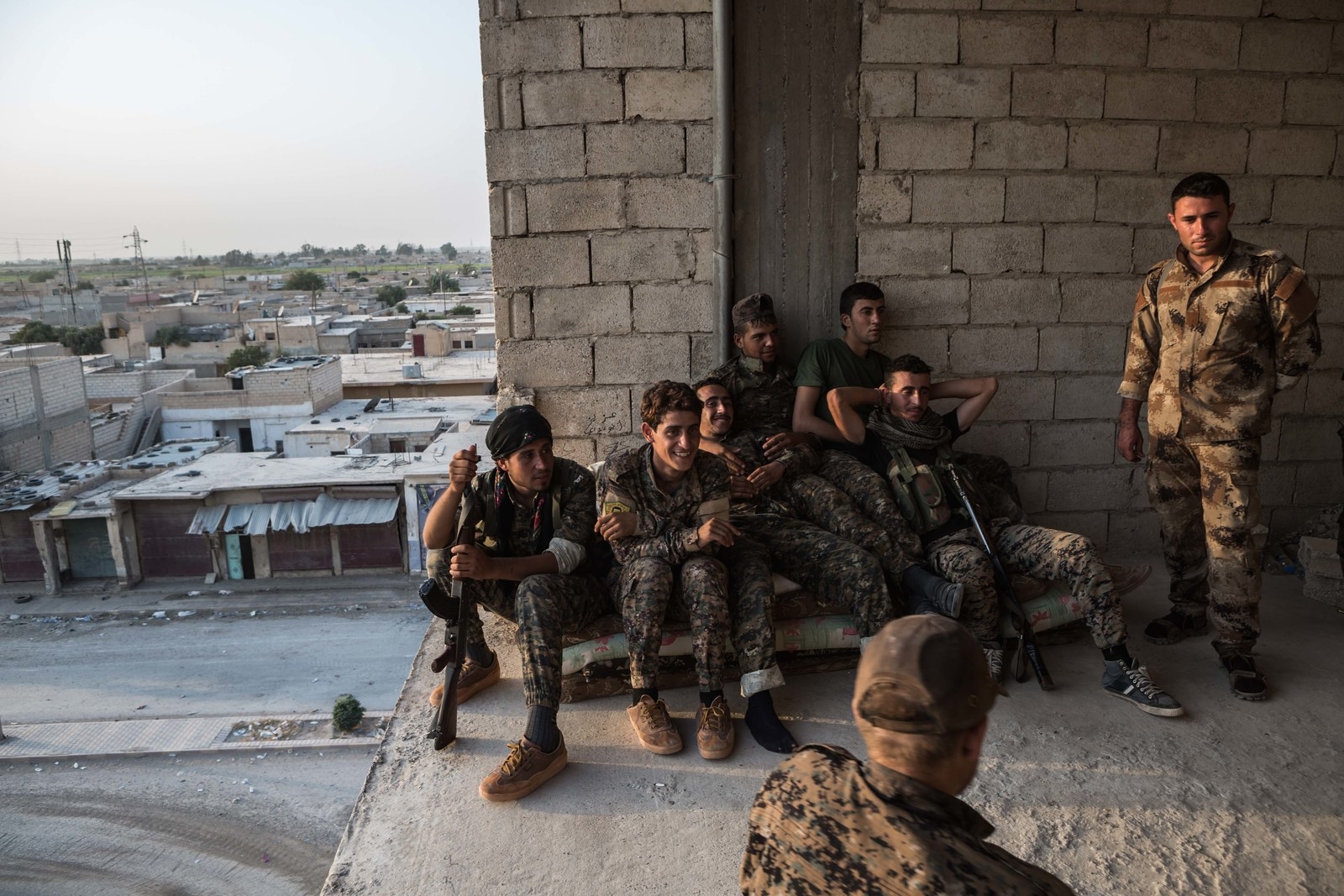
US involvement in the war against ISIS has changed markedly since Trump and his coalition of generals came to power. During the first years of the war against ISIS in northern Syria, under former president Barack Obama, the US kept a hands-off approach to the conflict, trying to limit its involvement. A US-led coalition aircraft might spot an ISIS position or vehicle and open fire, and fighters would move in afterwards if they were nearby. But now, under Trump, there is far closer coordination, in part because the US is less concerned about upsetting NATO partner Turkey by getting too close with Syria’s Kurds. When the SDF fighters get into trouble or need help to pave the way, they call in US airstrikes and artillery fire. And when the US forces see an opportunity to strike, they do so, before alerting Syrian fighters on the ground to move in. Acting in part on the recommendations of the outgoing Obama administration, the US has also expanded the flow of weapons and ammunition to the SDF.
The Trump administration has delegated more authority to military commanders on the ground, giving them considerable leeway to act quickly against ISIS positions. “Over the last six months, we have dramatically accelerated this campaign,” US Special Envoy Brett McGurk told reporters on Friday, discussing the war against ISIS in Syria and Iraq. “About six months ago, ISIS was planning major attacks in Raqqa. They were planning major attacks against the United States, against our partners, and they were doing it in Raqqa using infrastructure of a major city. Today in Raqqa, ISIS is fighting for every last block, and trying to defend blocks that they are about to lose. They are fighting for their own survival.”
The US and its Western coalition partners, especially the UK and France, have also become increasingly visible stakeholders in the war effort. In recent weeks, McGurk had visited northern Syria, meeting with local officials. Later came Alan Dwyer, a USAID disaster relief specialist, who appeared in Ain al-Issa, north of Raqqa. He arrived in a convoy of unmarked armored SUVs and a security detail made up of silent, muscular Americans in wraparound sunglasses. Dwyer met with local officials and representatives of the few Western aid organizations discreetly working to clear explosive ordinance and provide humanitarian help to Syrians displaced by the war. He was followed days later by the British army's Maj. Gen. Rupert Jones, who appeared before TV cameras after a lengthy meeting with Raqqa military and political leaders.
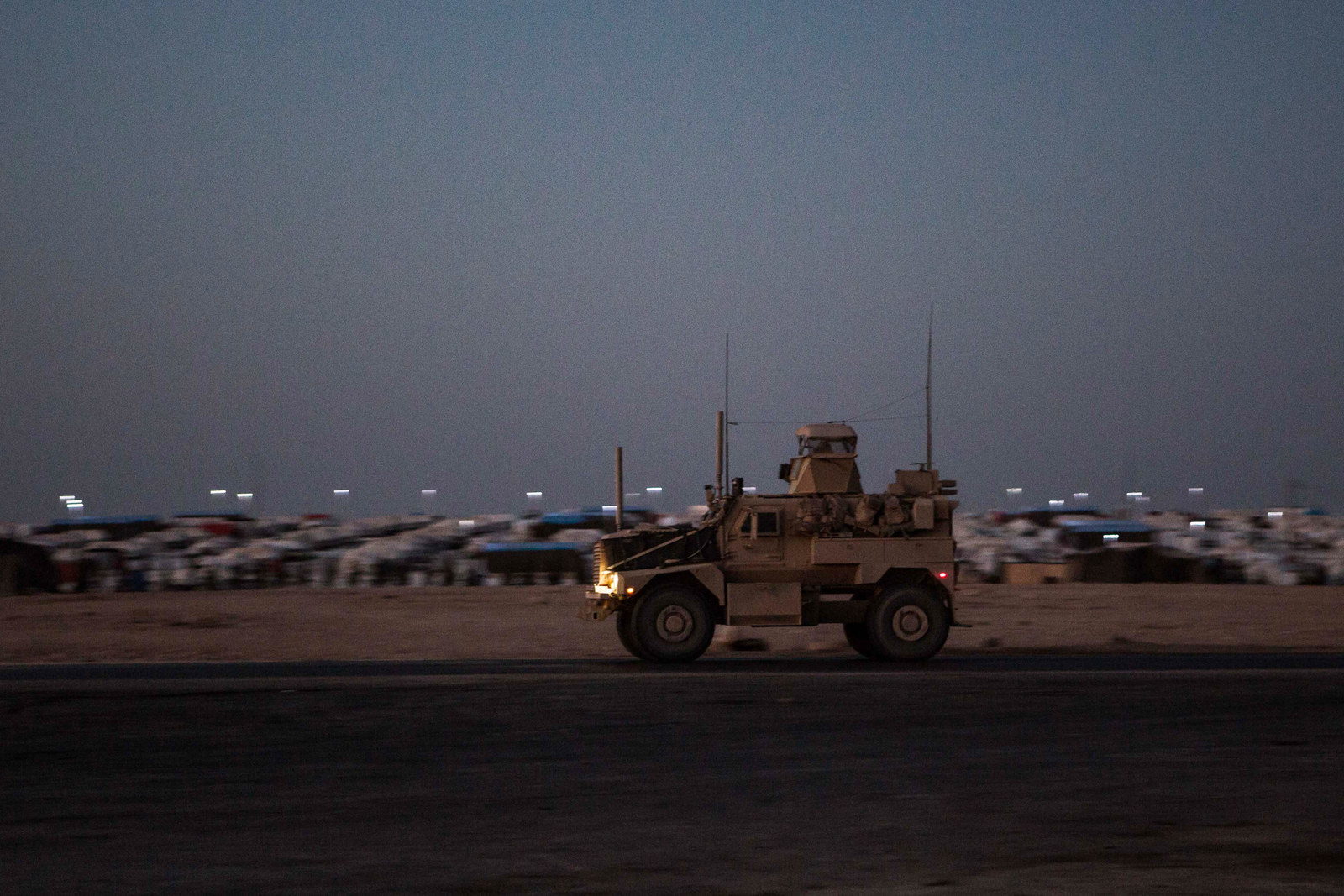
BuzzFeed News witnessed coalition vehicles — ranging from the mine-resistant, ambush-protected armored vehicles now used by US personnel in the Middle East, to military trucks carrying ammunition, Land Rovers driven by intelligence officers, and the Austrian-made Pandur armored vehicles favored by Delta Force — scouring the countryside on a daily basis, although officials and soldiers alike usually decline to speak when approached by the smattering of Western journalists in northern Syria.
US Army Col. Ryan Dillon, speaking to reporters, said the fighting in Raqqa “continues to be intense as fanatical ISIS dead-enders and foreign terrorist fighters left to die use the dense urban environment to try to cling to territory.” More than 80% of ISIS attacks against the SDF come from hidden improvised bombs.
Despite this, Western officials present a relatively upbeat picture of how the battle is going. “The Syrian Democratic Forces are making excellent progress fighting their way into Raqqa,” Jones, deputy commander of the US-led coalition effort in northern Syria, told reporters during a press conference on July 23 in Ain al-Issa, a town north of Raqqa that serves as the staging ground for the offensive. “The fight in Raqqa is no tougher than we expected. It’s every bit as tough as we expected.”
US officials estimate that it will take up to two months before Raqqa is cleared of ISIS and the crucial effort to restore life to the city can begin, even as fighters continue to chase the militants to the cities of Mayadin, Deir Azzour, and Abu Kamel, where the group’s leaders are believed to be holding up.
The US has so far been reluctant to let the world know too much about what it is doing on the ground in Syria. Unlike in Iraq or Afghanistan, Washington has no official invitation from Syria’s government in Damascus, and stopped disclosing numbers of deployed troops months ago. But there are believed to be around 2,000 US Army Rangers and Marines, along with Special Forces personnel, in Syria, and the Pentagon’s 2018 budget includes $500 million to train and equip Syrian forces fighting ISIS. With greater involvement comes greater responsibility. The US runs the risk of being blamed if the conflict spirals out of control — and the worst may be yet to come.
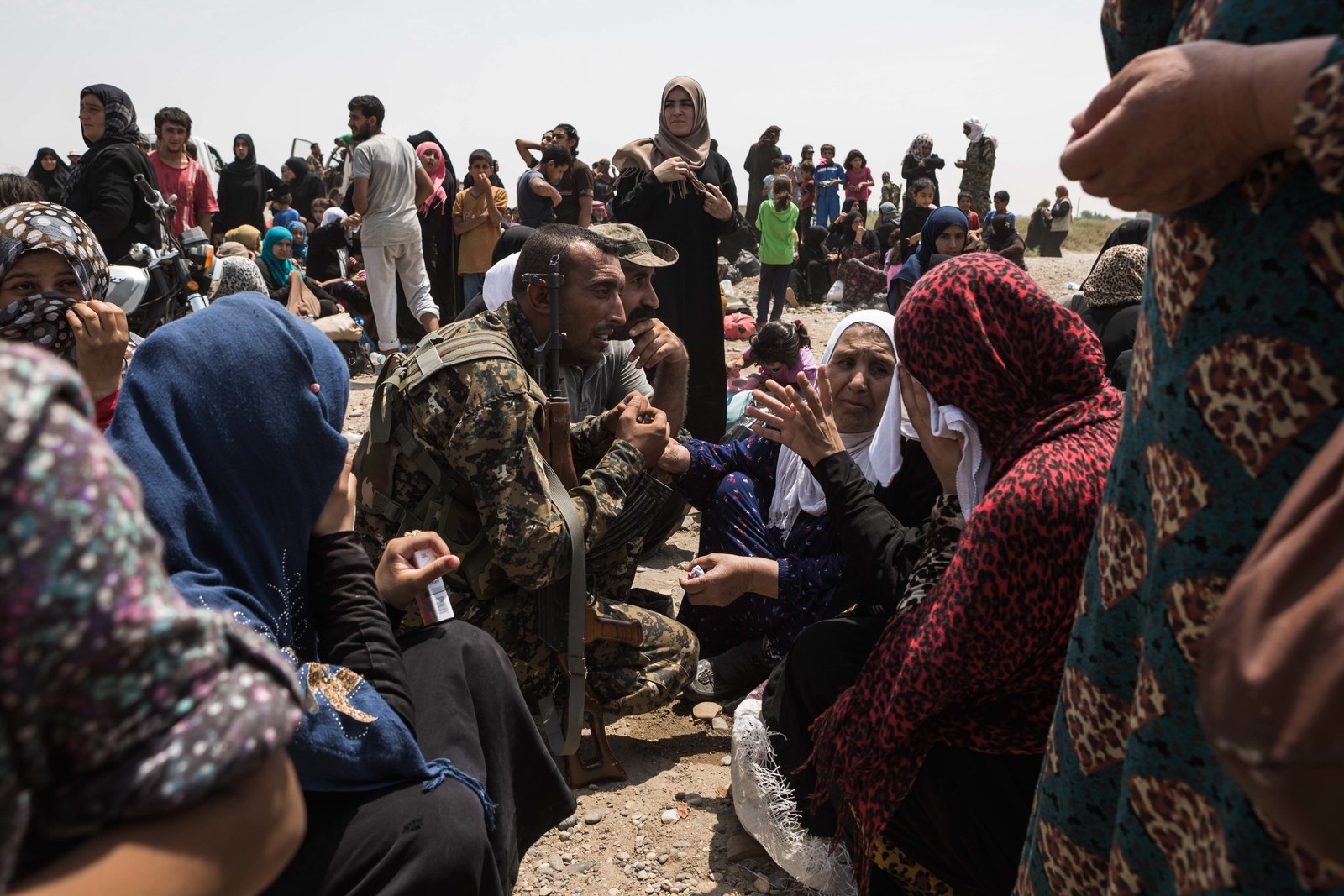
Shir likes to point out that the men he leads hail from across Syria’s mosaic of religions and people: Arabs, Kurds, Turkomans, and Christians. “They are like one family, like brothers,” he said, “and when they fight they fight as one man.”
That diversity may be key to the future success of the Raqqa operation, and is central to the US effort to present the Kurdish-led SDF as something more than a front for the aspirations of Syria’s autonomy-minded Kurds.
In an effort to build up goodwill among Raqqa’s residents — and win hearts and minds — the US-led coalition has been imploring the SDF to treat civilians well and encouraging locals to trust the Syrian forces. While a radio station run by ISIS warns listeners that they cannot be true Muslims if they do not obey the word of God, the SDF’s Voice of Raqqa broadcasts public service announcements assuring civilians the SDF will protect them, between Arab pop songs.
But the most important assistance both the US and the SDF are providing to civilians may be in helping getting life to back to normal as quickly as possible. Though McGurk insisted on Friday that the US wouldn't get involved in “nation-building,” he acknowledged Washington’s role in guiding Raqqa toward stability once ISIS is gone. Unlike in Iraq’s Anbar province, where civilians were kept out of territories liberated from ISIS for months, ordinary people are returning to their lives as soon as they can. Families sometimes go home within days of ISIS’s withdrawal, with tiny roadside shacks reopening to sell bottled water, canned food, cleaning supplies, milk cartons, and candy bars.
Civilians who make it out of Raqqa’s ruins are directed to fields just inside SDF-controlled territory. On a sweltering day in July, hundreds of people showed up on a patch of farmland within the network of canals just to the west of Raqqa. SDF fighters, rather than aid groups, were the first to arrive with help, handing out water to families. Some fighters gave out money supplied by a wealthy Arab tribe called the Abu Hadid, which has allied with the SDF. “Every time we see refugees, we give out money,” said one SDF fighter, as a group of children gathered around him to collect Syrian 200-pound notes, now worth around 40 cents. Many of the displaced families said they had been paying smuggler after smuggler to escape ISIS-controlled territory and were broke by the time they finally got out of the city.
“They are not trained well and are not even adults. Some of them are 18 years old ... They are sacrificing too much.”
Fadi Ramadan and his family were among a group of Raqqa neighbors who had moved nearly 10 times since Syria’s troubles began in 2011, each time losing money to smugglers as well as household goods he was forced to leave behind. They finally decided it was time to abandon Raqqa in June, after listening for days to the bombing and the sounds of anti-aircraft guns. The power had long gone out, and they were melting in the heat. Families usually emerge when they run out of water or bread, but Ramadan, a 36-year-old minivan driver, knew that their money was running out, and that they would need at least a few hundred dollars to pay the smugglers to get them out. They bundled up whatever possessions they could in shopping bags and stuffed them into his van.
Ramadan and his family knew their escape would be risky, but staying put was untenable. Many of the male relatives had already been locked up in ISIS prisons or flogged for minor infractions, like being late for Friday prayers. They dreaded what ISIS might to do to them as the group retreated from the city or came under increasing military pressure. “We left in the middle of the night, when the coalition planes had stopped bombing,” he recalled. “The smuggler took us to a point and just said, 'Drive forward until you get to the SDF checkpoint.'”

Fleeing ISIS territory is perilous. The militant group has a history of firing on civilians attempting to escape its control. At one field hospital in eastern Raqqa, a twentysomething man was brought in by SDF fighters, a gaping mortar wound in his chest, his body covered in blood. He had been trying to escape Raqqa when he was fired on by ISIS militants as he approached the SDF lines, and bled out in a pickup truck as he was rushed to a makeshift storefront clinic mostly used to treat wounded fighters.
Trucks loaded up those displaced from Raqqa and transported them to one of two camps: Karama, to the east, or Ain al-Issa, to the north. Ramadan’s family didn’t need a lift, just a little diesel to take them and another group of people to Ain al-Issa. After arriving at the camps, SDF fighters check the names of the displaced against a coalition database of known ISIS fighters. Then the men all do the same thing: They go to the barber and get the bushy beards demanded by ISIS shaved off. “How would you feel if you’re not allowed to shave for years?” said Ahmed Hassan, a 42-year-old who runs one of two barbershops at the Ain al-Issa camp.
More than a quarter of a million people have passed through the camp at Ain al-Issa, where nearly 6,800 people live in 1,064 UN tents. Ramadan and his family are lucky. He stuck a sticker given out by the UN refugee agency on his minivan and managed to find work running errands for relief groups. At dinnertime, his wife prepared a stew of fresh tomatoes, potatoes, and chicken on a gas stove by the family’s tent.
“There’s a lot of displacement,” said a senior US official involved in humanitarian efforts in northern Syria during a visit to Ain al-Issa. He spoke on condition of anonymity because he was not authorized to speak to the press. “Families are escaping ISIS. We’re doing a lot on the humanitarian side to protect civilians. So the challenge now is to make sure people get food, water, hygiene items. If you were here two months ago you saw people sleeping on the side of the road.”
US officials say nearly half of Raqqa has been freed of ISIS’s grip. Their Syrian counterparts say the hard part will begin after the battle is done. “Everybody knows the war will end soon,” said Omar Alloush, cochair of the Raqqa Municipal Council, the US-backed authority getting ready to take over the capital of ISIS’s self-declared caliphate once it is cleared of the jihadi group. “But the main problems will come after the liberation.”
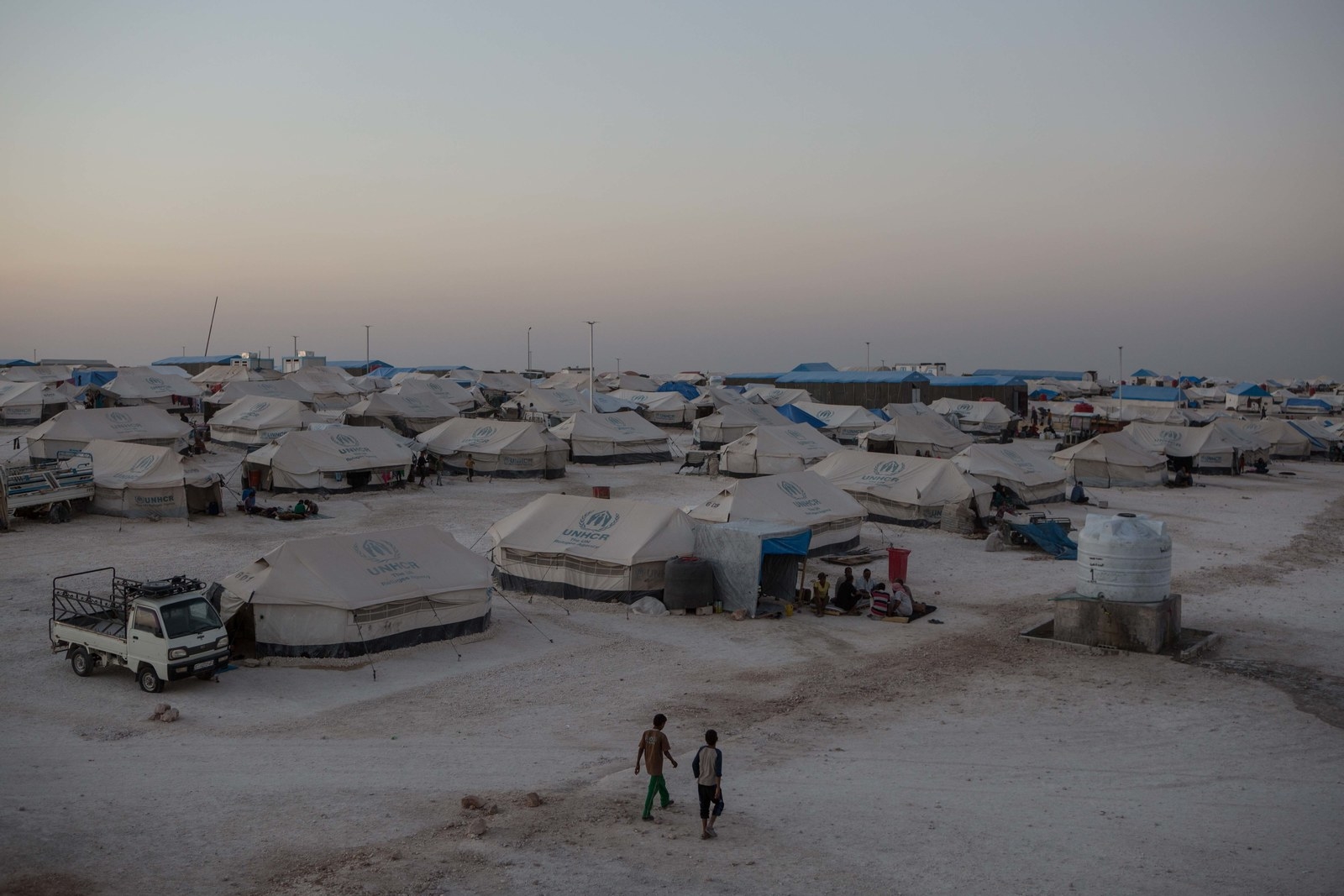
In many months of fighting ISIS, Shir claims he has never lost a man. Despite numerous and sometimes catastrophic injuries along a fragmented and constantly shifting front line, not one of his men has yet died. It is a record he wants to keep. And unlike other commanders, Shir strayed from the party line that the war against ISIS was going well.
Faced with overeager troops — and perhaps pressure from senior leaders of the SDF — other commanders were sending too many insufficiently trained and inexperienced fighters into battle, he said, and it was causing too many casualties.“They are becoming martyrs because they are not protecting themselves and not following orders,” he said. “They are not trained well and are not even adults. Some of them are 18 years old. How can an 18-year-old fight? They should have training for years or at least months before going into battle. They are sacrificing too much. You are not even 18 and you show up to fight. This is how we lose so many people. And the commanders bear some responsibility.”

Syria’s Kurds have already made enormous sacrifices in the war against ISIS. And each death has a political cost. Dreay Hussein, a 58-year-old taxi driver, and his wife and children were among hundreds of families gathered to honor the dead at a mid-July candlelight ceremony at the martyrs’ cemetery in Kobane, about 100 miles northwest of Raqqa near the Turkish border. His wife dried her tears as she placed a candle at the grave of their 19-year-old son Mazloum, who died two years ago in battle. Hussein demanded that his family’s loss not be in vain. “We hope to have something from our father Trump,” he said, reflecting a surge of support Syria’s Kurds feel towards the president who has increased US involvement in the war against ISIS. “We hope that the West, especially our father America, will allow us to have a state, an independent state.”
For many of Syria’s Kurds, the war is a precursor to their effort to legitimize their self-ruled enclave, called Rojava, which they declared in 2012 amid Syria’s spiraling chaos. Rojava, which means “Western Kurdistan” in the Kurdish language, is a semiautonomous territory that stretches from Syria’s northeast corner to the Euphrates River along the Turkish border, and includes another pocket in northwest Syria. The SDF’s best fighters and commanders are members of the People’s Protection Units, or YPG, a Syrian offshoot of the PKK. That’s the autonomy-minded Kurdish militant group at war with NATO member Turkey and listed as a terrorist organization by Ankara, the US, and the EU.
The US partnership with the SDF remains diplomatically awkward. In July, US Army Gen. Raymond Thomas, the head of Special Operations Command, publicly acknowledged what many officials and scholars have known: that the SDF is a little more than a front for the YPG. Speaking at the Aspen Security Forum, he said that the YPG had simply been rebranded to make it more palatable to Turkey. “I thought it was a stroke of brilliance to put democracy in there somewhere,” he said.
Many of the SDF fighters are loyal to PKK founder Abdullah Ocalan, who now sits in a Turkish prison and is seen by many Turks the same way Americans saw Osama bin Laden. It is Ocalan’s vision of “democratic confederalism,” a kind of decentralized socialism, that guides Rojava. “This man is the one who created this democratic system,” said Shir’s 24-year-old deputy Nihad Khalid Ali, who, like many SDF fighters, wears an Ocalan patch on his shoulder. “For us he is like an older brother. He gives us a practical new system. We are following his system, thoughts, and philosophy.”
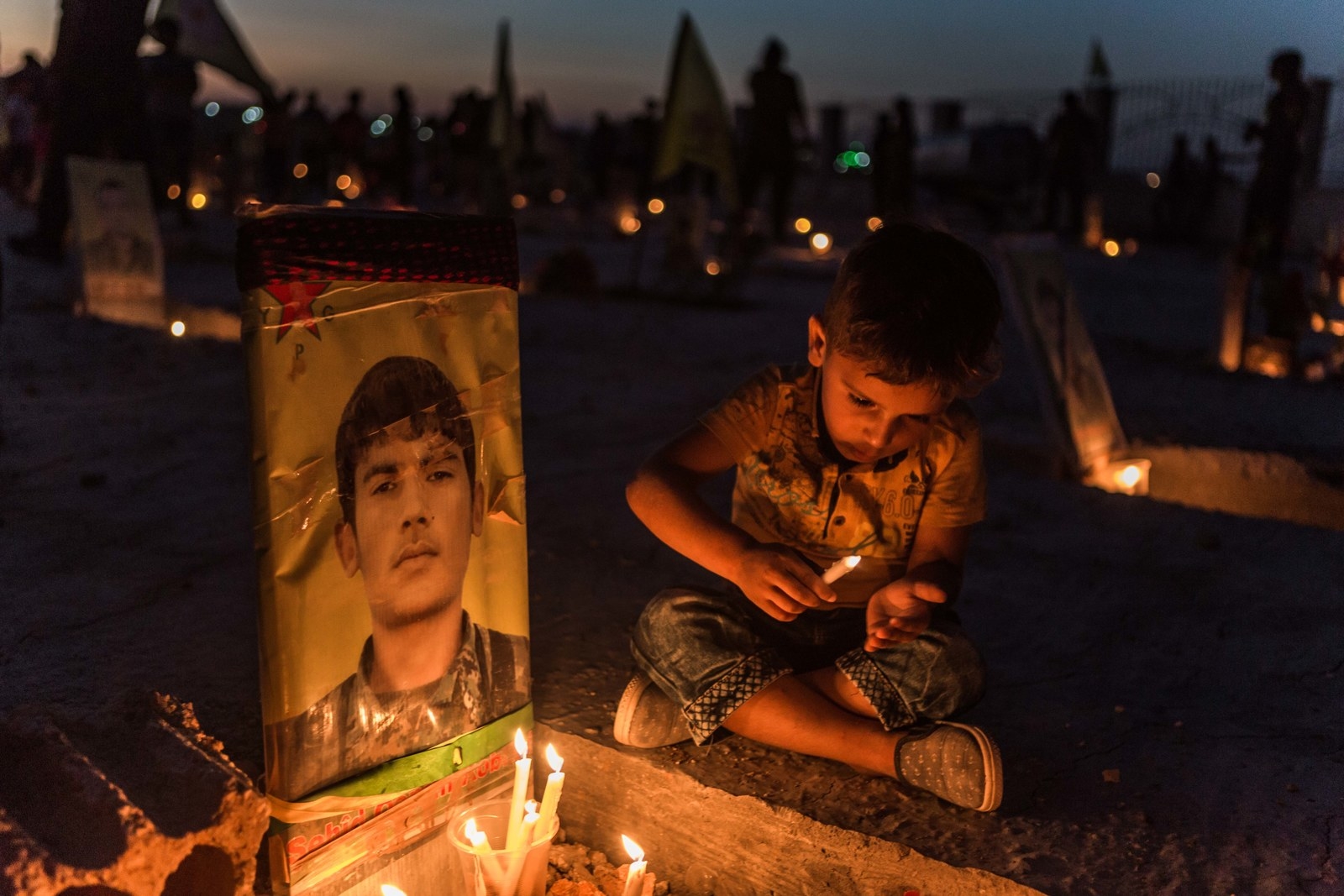
Many wonder whether the Kurdish-led militias will seek to annex Raqqa, and any other mostly Arab territories they take from ISIS, into Rojava. Others insist that the people of Raqqa will decide which flag flies over the city once the militants have gone, whether it’s the colors of the Syrian regime, the unofficial flag of Rojava, or the pre-Bashar al-Assad Syrian banner favored by his Arab opponents.
US forces, meanwhile, are helping train hundreds of young men as part of a newly formed Raqqa Internal Security Force that will take control of the city’s streets and prevent ISIS fighters from escaping once the battle is over. “We will be very grateful to the SDF,” said Alloush, the cochair of the Raqqa Municipal Council, “but they will have to hand over power to the local council within hours.”
For now, many of Raqqa’s residents welcome the SDF. It has treated ordinary Syrians far more benevolently than ISIS, the Syrian regime, or the jihadi rebels operating in Syria’s far northwest. The SDF has offered a stability in the north that has been lacking throughout much of the country since Bashar al-Assad’s gunmen opened fire on peaceful protesters in 2011 and ignited Syria’s civil war.
“Rojava is working,” said Commander Omid of the Syriac Military Council, a 1,000-man Christian militia that is part of the SDF. “You have three different populations, three different religions. Rojava is the only way to give each other our rights.”
But even some of Omid’s own men and other SDF fighters are ambivalent about the ultimate aims of their leaders, who include Kurdish PKK leaders from Turkey who don’t even speak Arabic.
Northern Syria’s Kurdish authorities may be more benign than their enemies, but they have also been accused of human rights violations and ethnic cleansing.
“For us the war won’t be over when ISIS is defeated.”
Many Syrians in the north worry about how neighboring Turkey, which has already blockaded Rojava and occasionally bombs positions inside, might treat an enclave so thoroughly under the sway of the PKK or its allies. Large numbers of them resent Rojava’s imposition of obligatory nine-month military service for all men aged 18 to 30, including 40 days of basic training that is heavy on the PKK’s ideological indoctrination. Ocalan’s murky theories and the language used by some SDF fighters can be alienating.
“For us the war won’t be over when ISIS is defeated,” said Darya Soleen, a 24-year-old fighter in the SDF and a staunch Ocalan supporter. “When the war is over the ideological war begins. The reality is we have to change the mentality of the society. We will start to rearrange the society. That’s the real challenge.”
Syria’s Kurds are known for their women fighters like Soleen and Roza Rumeilan, who are on the front lines in Raqqa. Rumeilan, a 20-year-old, was upbeat about the war as she walked through the bombed-out buildings and sniper outposts along the eastern front of Raqqa. But there was a tough, bleak edge to Rumeilan’s outlook on life that might clash badly with any future hopes the US and its allies have to restore peace to Syria. She said she had no interests other than the war effort and could barely remember what life was like before she became a fighter. “We don’t think about the future,” she said. “It’s a fighting life. Your life is fighting. For me fighting is the ideal life, and we will fight until we get our freedom.”
Ossama Muhammad and Andrea DiCenzo contributed reporting
Outside Your Bubble is a BuzzFeed News effort to bring you a diversity of thought and opinion from around the internet. If you don't see your viewpoint represented, contact the curator at bubble@buzzfeed.com. Click here for more on Outside Your Bubble.


